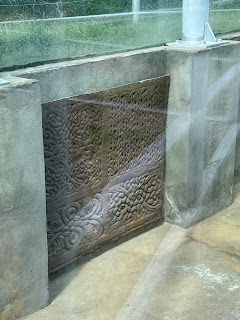After a very comfortable night & wonderful breakfast in Tongue, the Kyle of Tongue bridge took us out of town towards the causeway & a beautiful scenic & we came across the most perfect (in my mind) harbour & lighthouse.
We stopped at the top & looked down on the most beautiful white crescent sands & a few boats bobbing along near it - a double beach. It looked so idyllic that it was hard to tear myself away & the photos do not do it justice.

This area is known for a dark period of history - the Highland Clearances, forced evictions of thousands of tenant farmers & their families. It is a complicated time in Scottish history that I am not fully up to speed on so the info on the link is probably the best history.
This north western part of Sutherland is stunning.
The gift of time is wonderful; we booked hotels that we not too far apart so we could have a full day to explore between them, especially as the coast is so fascinating. There is always so much to see & do that you have to just decide what you want from each stretch, it leaves you wanting more ...
Smoo cave is a must stop, a unique cave accessed by a long path down to the beach below.
There is a very good overview of its
position in this image - a unique cave worth the visit & steps
On the Durness coastline, we stopped at
Balnakeil & the ruined church & graveyard. It is an interesting place with the MOD occupying part of
Faraid Head where there is an abundance of wildlife & coastal birds as well as seals. The Scottish
poet Rob Donn is buried in this graveyard.


A beautiful stretch of beach lies below the church, another pristine sandy one with beautiful turquoise waters.
 Castle Ardvrek
Castle Ardvrek is another landmark castle along the way - I decided to take photos of the names on the map because you start to forget which is which along the way when there is so much to see. It is perched on an island, accessible only by a narrow band of shingle beach. It was originally built by the MacLeod's of Assynt in 1590 & is said to be haunted by the weeping daughter of the Macleod chief.
It was absolutely tipping down with rain so we did not walk to the castle but stopped at the lookout to enjoy it. However, it was interesting to see a small rowing boat with 2 people in it out on the choppy waters, like time stood still.
This coastline again has such stunning crescent shaped coves & beaches but the weather was turning & we did not have the sunlight to do it all justice.
Kylesku Bridge is a known landmark & it is impressive, worth stopping at the pull in before to appreciate the engineering & beauty of it with the Assynt mountains behind it. It was only built in 1982 but has been recognised as a innovative structure. You do not fully appreciate it when driving over so the look out stop is essential (along with a coffee & something sweet at the catering van there)
The weather had turned & it highlighted the dramatic landscape of high mountains, many with snow now & the deep valleys with intense greenery.
The Old Man of Stoer lighthouse & stacks were another impressive stop, they are a real landmark along this coast too.
The Stoer Head Lighthouse is a beacon with its white structure & yellow details. Lighthouses are always perched up high & this means the winds really get up & you can appreciate the rough seas & rocks below. It is dramatic looking out on the wild seas ...

No seaside stay is complete without a walk around the harbour & a fish & chip supper. I am rather partial to fish & chips at the coast & this was a very generous portion that hubby helped me finish (he had fish too, but not with chips so he was happy to help out.)
Ullapool, like many towns along this coastline, is a ferry port to the various Islands, this one to Stornoway & the outer Hebrides. Several guests at our hotel were up bright & early to catch the morning ferry after breakfast.
Ullapool was founded in 1788 & the port was designed by the famous Scottish Engineer Thomas Telford (also designer in Wick)
Leaving Ullapool, you drive along the picturesque Loch Broom with its windy road & impressive mountains. To be continued, do follow, share & enjoy,
Dee 🛳️⛴️🚣♂️🚤⚓️





























.jpg)



































